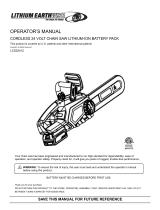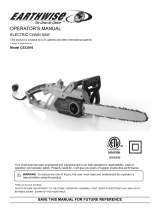
whatyouaredoing.Usecommon
sense.
• Donotstartcuttinguntilyouhavea
clearworkarea,securefooting,and
especiallyifyouarefellingatree,a
retreatpath.Keepworkareaclean.
OPERATEYOURSAW SAFELY
• Do not operate with one hand. Seri-
ous injury to the operator, helpers, or
bystanders may result from one-
handed operation. A chain saw is in-
tended for two-handed use.
• Do not operate saw from a ladder or
in a tree.
• Make sure the chain will not make
contact with any object while starting
the saw. Never start the saw when
the guide bar is in a cut.
• Do not force chain saw. It will do the
job better and safer at the rate for
which it was intended.
• Do not put pressure on the saw, es-
pecially at the end of the cut. Doing
so can cause you to lose control
when the cut is completed.
• Stop the saw before setting it down.
• Hand carry saw only when motor is
stopped. Carry the chain saw by the
front handle with the saw stopped, fin-
ger off the switch, the guide bar and
saw chain to the rear.
• Use the right tool, cut wood only.
Don't use chain saw for purpose not
intended; for example, don't use
chain saw for cutting plastic, mason-
ry, non-wood building materials.
• Do not operate a chain saw that is
damaged, improperly adjusted, or
not completely and securely as-
sembled. Always replace bar, chain,
hand guard, or other parts immedi-
ately if they become damaged, bro-
ken, or are otherwise removed.
• Inspect chain saw cords periodically
and if damaged, have repaired by a
Sears Service Center.
MAINTAIN YOUR SAW IN GOOD
WORKING ORDER
• Have all chain saw service per-
formed by a Sears Service Center
except the items listed in the MAINTE-
NANCE section of this manual.
• Make certain saw chain stops mov-
ing when trigger switch is released.
• Keep the handles dry and clean and
free from oil and grease.
• Keep oil cap and fasteners securely
tightened.
• Nonconforming replacement compo-
nents or the removal of safety devices
may cause damage to the unit and
possible injury to the operator or by-
standers. Use only Craftsman acces-
sories and replacement parts as rec-
ommended. Never modify your saw.
• Maintain chain saw with care.
• Keep unit sharp and clean for better
and safer performance.
• Follow instructions for lubricating and
changing accessories.
• Unplug the chain saw from the power
source when not in use, before servic-
ing, and when changing accessories
and attachments, such as saw chain
and guard.
• Check for damaged parts. Before fur-
ther use of the chain saw, a guard or
other part that is damaged should be
carefully checked to determine that it
will operate properly and perform its
intended function. Check for alignment
of moving parts, binding of moving
parts, breakage of parts, mounting and
any other conditions that may affect its
operation. A guard or other part that is
damaged should be properly repaired
or replaced by a Sears Service Center
unless otherwise indicated elsewhere
in the operator's manual.
• When not in use, chain saws should
be stored in a dry, high or locked-up
place out of the reach of children.
• When storing saw, unplug and use a
bar sheath or carrying case.
ELECTRICAL SAFETY
_I, WARNING: Avoid a dangerous
environment. To reduce the risk of
electrical shock, do not use in rain, in
damp or wet locations, or around
swimming pools, hot tubs, etc. Do not
expose to snow, rain, or water to avoid
the possibility of electrical shock. Do
not handle extension cord or plug with
wet hands.
• Use only a voltage supply as shown
on the nameplate of the unit.
• Avoid dangerous situations. Do not
use in the presence of flammable liq-
uids or gases to avoid creating a fire
or explosion and/or causing damage
to unit.
• To reduce the risk of electrical shock,
this appliance has a polarized plug
(one blade is wider than the other) and
will require the use of a polarized ex-

















